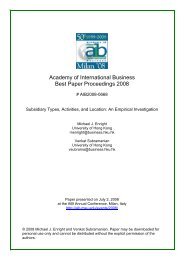AIB 2012 Conference Proceedings - Academy of International ...
AIB 2012 Conference Proceedings - Academy of International ...
AIB 2012 Conference Proceedings - Academy of International ...
Create successful ePaper yourself
Turn your PDF publications into a flip-book with our unique Google optimized e-Paper software.
SUNDAY<br />
negative effect depends on a focal firm's market experience. (For more information, please contact: Seong-<br />
Young Kim, EMLYON Business School, France: kim@em-lyon.com)<br />
How Do Alliance Partners Share the Value They Create Determinants <strong>of</strong> the Value Split in <strong>International</strong><br />
Technology Transfer Alliances<br />
Farok J. Contractor, Rutgers University<br />
James Woodley, Ramapo College<br />
This paper tests different determinants <strong>of</strong> partner shares <strong>of</strong> alliance returns, for a sample <strong>of</strong> cross-border<br />
technology transfer alliances. Findings suggest the importance <strong>of</strong> bargaining power as an influence on partner<br />
shares <strong>of</strong> alliance returns and suggest that firms with better absorptive capacity gain more from alliances. There<br />
is a positive correlation between risk and return in alliances; in other words, firms that want a greater share <strong>of</strong><br />
total returns from an alliance may be able to reach that objective by also agreeing to accept more risk or<br />
volatility. On a related point, shifting risk to a partner by insisting on minimum sales or minimum royalty<br />
requirements is typically accompanied by a smaller share <strong>of</strong> total alliance returns for the partner <strong>of</strong>floading risk.<br />
Finally, the findings suggest that return and risk are evaluated in a holistic manner by those negotiating and<br />
designing alliances. Implications for theory and practice are explored and further research about issues raised in<br />
this paper is recommended. (For more information, please contact: Farok J. Contractor, Rutgers University,<br />
USA: farok@andromeda.rutgers.edu)<br />
To Compete or to Cooperate: Contrasting Distance Determinants for Semiconductor Alliances<br />
Sonya H. Wen, Tamkang University<br />
How do competitive dynamics between partners impact alliance strategies To approach such inquiry, we<br />
devised a hypothesized governance model by applying the literature <strong>of</strong> competitive dynamics and knowledgebased<br />
view in the empirical context <strong>of</strong> technology intensive alliances. Two contrasting hypotheses driven by<br />
competitive tension versus cooperative incentives are developed and then tested on a sample <strong>of</strong> 1,696<br />
Semiconductor alliances during 1985 and 2008. These sampled alliances formed by actual and/or potential<br />
competitors are intentionally selected to magnify the hypothesized contrasting governance effects <strong>of</strong> multidimensional<br />
distance determinants. We posit that driven by cooperation that the higher cooperative barriers or<br />
higher distance, and contrastingly driven by competition, the higher resource similarity or lower distance<br />
between alliance partners, the higher propensity <strong>of</strong> equity-base mode to safeguard their comparative<br />
advantages against competitors. We found empirical support <strong>of</strong> both hypotheses on the direct or contingent<br />
governance effects <strong>of</strong> six distance determinants. In comparison, our research demonstrates that the governance<br />
driver <strong>of</strong> cooperative incentives stronger than competitive tension, as well as weaker governance effects <strong>of</strong><br />
cultural distance than the distance dimensions <strong>of</strong> power, coordination, knowledge, and experience. Such<br />
contrasting results support our call for more alliance research to analyze the strategic dynamics between<br />
competition and cooperation. (For more information, please contact: Sonya H. Wen, Tamkang University,<br />
Taiwan: sonya.wen@gmail.com)<br />
Exploring the Influence <strong>of</strong> Institutional Embeddedness <strong>of</strong> Partner Firms on Inter-Partner Dynamics in<br />
<strong>International</strong> Strategic Alliances<br />
Swetketu Patnaik, University <strong>of</strong> Kaiserslautern<br />
The article aims to demonstrate the influence <strong>of</strong> institutional embeddedness on the practices that organizations<br />
adopt in international strategic alliances and their implication on alliance dynamics. Whereas most studies, in<br />
international business, explore the dynamics <strong>of</strong> institutional arrangements in the context <strong>of</strong> issues relating to<br />
host country partner selection, little is known on how institutional embeddedness <strong>of</strong> partner firms have an<br />
influence on the dynamics <strong>of</strong> inter-organizational relations. Our paper, based on a longitudinal study <strong>of</strong> two cooccurring<br />
international strategic alliances <strong>of</strong> an Indian biopharmaceutical firm explores how institutional<br />
embeddedness <strong>of</strong> partner firms influence their alliance formation activities, the approaches they adopt to<br />
<strong>AIB</strong> <strong>2012</strong> <strong>Conference</strong> <strong>Proceedings</strong><br />
Page 97

















